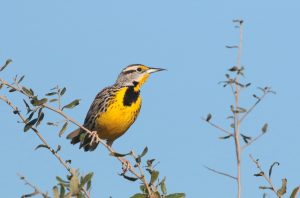-

The importance of greenspaces within urban areas provides essential habitats for the migrating Eastern Meadowlarks above and the Magnolia Warbler below. Human activities cause changes to wildlife biodiversity co-existing on urban and agricultural lands.
- For birds, little is known about the factors or extent these human activities impose on their biodiversity as they co-exist in neighborhoods, commercial communities, and agricultural lands.
- A new University of Florida study confirms a decline of bird biodiversity in urban and agricultural settings across the United States because of habitat changes by human activities.
A UF/IFAS study published in the journal of Ecography today shows a decline in bird biodiversity across the United States in urban and agricultural areas. The changes stem from human activities modifying or disturbing their habitats.
“We know anthropogenically modified environments can negatively impact biodiversity by decrease the number of species” said Corey Callaghan, assistant professor of global ecology at UF/IFAS Fort Lauderdale Research and Education Center. “In our study, we learned that as you go from natural areas to human-modified areas, the number of individuals that can persist decreases, which then influences species richness.”
Birds are one of the most observed and studied species due to their appeal by birdwatchers of all ages and to scientists and conservationists for their status as ecological indicators. While much research has been dedicated to highlighting patterns of bird diversity and how changes occur along different urban and agricultural environments, the scope of change has been a challenge to confirm as well as the conditions by which the change occurs.
“Luckily, citizen science datasets such as eBird allow for increasingly broad-scale studies in space and time, which provide an exceptional dataset to answer some of these questions,” said Callaghan.
 For the study, scientists used a combination of datasets. Birdwatchers are a vital source to help scientists gather data about the avian community. For this reason, the scientists started by compiling bird data from the eBird citizen science app. The eBird app enlists volunteer birdwatchers to submit a list of all bird species and the abundance of each species they hear and/or see while birdwatching. They are known as checklists in the app. eBird is among the world’s most significant biodiversity-related science projects, with more than 100 million bird sightings contributed annually by eBirders around the world.
For the study, scientists used a combination of datasets. Birdwatchers are a vital source to help scientists gather data about the avian community. For this reason, the scientists started by compiling bird data from the eBird citizen science app. The eBird app enlists volunteer birdwatchers to submit a list of all bird species and the abundance of each species they hear and/or see while birdwatching. They are known as checklists in the app. eBird is among the world’s most significant biodiversity-related science projects, with more than 100 million bird sightings contributed annually by eBirders around the world.
Using more than 90,000 of these checklists across the continental United States, the scientists found strong evidence of an overall decline in bird diversity along a human-modified gradient, from natural areas to areas with high human activities, such as urban or agricultural areas.
Callaghan highlights that this result is “unimodal,” meaning that there is a peak in diversity around the rural-suburban interface. This suggests that small and local actions can have a positive impact on biodiversity. In other words, despite the decline of bird diversity in urban environments, scientists say there is still hope for building biodiversity bird species in urban areas so long as humans adopt inviting changes to their surrounding environment.
Callaghan suggests introducing native plants and shrubs to landscapes, researching and placing the right bird feeder for your area, and providing wildlife cover. If you must cut down a standing dead tree or one dying due to disease, lightning or animal damage, consider leaving the lower trunk as a snag. They serve as inviting nesting cavities for woodpeckers for example. On a grander scale, municipalities and communities can implement urban forests and utilize urban forest remnants as buildings for birds to influence and promote bird conservation in urban areas.
###
By Lourdes Mederos, rodriguezl@ufl.edu
ABOUT UF/IFAS
The mission of the University of Florida Institute of Food and Agricultural Sciences (UF/IFAS) is to develop knowledge relevant to agricultural, human and natural resources and to make that knowledge available to sustain and enhance the quality of human life. With more than a dozen research facilities, 67 county Extension offices, and award-winning students and faculty in the UF College of Agricultural and Life Sciences, UF/IFAS brings science-based solutions to the state’s agricultural and natural resources industries, and all Florida residents.
ifas.ufl.edu | @UF_IFAS
 3
3

